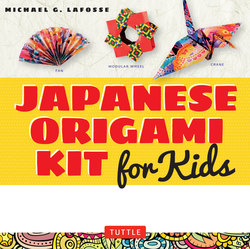Читать книгу Japanese Origami Kit for Kids Ebook - Michael G. LaFosse - Страница 6
На сайте Литреса книга снята с продажи.
ОглавлениеIntroduction
The idea of folding materials is an ancient one. Think of the advantages: Folding cloth makes it easy to carry. Folding a letter written on paper keeps its contents secret to the casual passerby. Wrapped in paper, food, medicine or gifts stay clean and fresh. Documented thoughts, such as stories or journal accounts, are more convenient to carry around and read when the written papers are fanfolded into a book.
With origami, the paper becomes more than just a wrapper, because the design of the folded paper is interesting in some way. Origami is a special type of paper folding that results in a beautiful pattern, a representation of a living thing, or a clever object. In Asia, spiritual symbolism has been expressed through folded paper shapes and forms.
One of the wonderful aspects of origami is its simplicity. The folder needs no glue, no tape, no string or wire—just a piece of paper! Though the materials are simple, origami exemplifies the ability of the human mind to solve problems and create beautiful harmony. Folding is relaxing and peaceful, but it is also fun and exciting to invent new ways to fold paper. The satisfaction of producing a work of beauty, or discovering something, such as a form that you have never seen before, can be addictive. Certain folders specialize in creating origami puzzles, or action models—origami that has moving parts—to the delight people of all ages.
The Chinese are credited with the invention of paper, and they were probably the first to create folded paper designs. But today, paper folding is known the world over as origami, a Japanese word. There are several possible reasons for this, but perhaps the most plausible is the existence of the Japanese origami crane, one of the most popular designs around the world. This folded paper classic is well documented in Japan’s history, and has been folded for at least 400 years. For many years the paper crane was considered the most advanced model in the world. When modern publishers and promoters of paper folding needed a simple word for the art, they looked to Japan, the home of the folded paper crane, and came up with origami. In Japanese ori means to fold and kami means paper.
Since papermaking and paper folding began in Asia, the origami projects presented in this book naturally convey aspects of Asian culture. Flip through these pages and you’ll discover a world of Lotus Blossoms, Koi fish, and Darumas!
